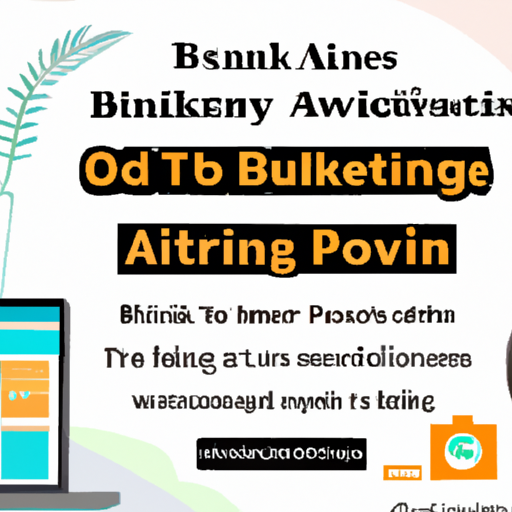In this friendly discussion, you’ll explore the potential profitability of blogs with Amazon affiliate links. You’ll learn how to automate your blog creation using AI and cloud-based software, transforming your Amazon affiliate links into a lucrative endeavor with comprehensive product reviews.

Understanding Amazon Affiliate Blogs
Defining Amazon Affiliate Blogs
Amazon Affiliate Blogs are a type of website where bloggers create content related to Amazon products, embedding affiliate links in the posts. When your readers click on those links and make a purchase, you earn a commission from Amazon. Think of it as a way for Amazon to reward you for directing potential buyers their way.
How Amazon Affiliate Program Works
The Amazon Affiliate Program, also known as Amazon Associates, is a marketing program where bloggers and website owners can earn money by promoting Amazon products. You start by signing up on their website and adding affiliate links to your blog. Whenever your readers click your links and buy products from Amazon, you earn up to 10% in referral fees.
Benefits of Amazon Affiliate Links for Bloggers
Amazon affiliate links are a great monetization strategy for bloggers. Firstly, Amazon boasts an incredibly vast product range, providing you with unlimited niches to target. Secondly, because it’s a trusted name, readers won’t hesitate to purchase. Lastly, you can earn a commission on anything the user buys within 24 hours of clicking your link, even if it’s not the item you recommended.
Harnessing AI for Blog Creation
Using AI to Generate Blog Content
With advancements in AI technology, writing blog posts can be automated. AI can generate drafts, summarize articles, research content, and even create engaging headlines. This can free up your time, allowing you to focus on improving your blog’s overall strategy.
Aiwisemind: A Revolutionizing Autoblogging Software
Aiwisemind is a cloud-based autoblogging software powered by AI. It assists in creating blogs on autopilot while incorporating your Amazon affiliate links and product reviews into the posts. This tool streamlines your content production, allowing you to focus on promoting your blog and earning passive income.
Automating Blog Updates with AI Tools
AI-powered tools can automatically update your blog posts with new content, relevant product links, and SEO-friendly touch-ups. As a result, your blog remains fresh and frequently updated, which is a positive signal to both your readers and search engines.
Developing Blogs with Amazon Affiliate Links
Selection of Niche for Your Blog
The success of your Amazon affiliate blog highly depends on choosing the right niche. It’s crucial to select a topic you are passionate about and have deep familiarity with. This way, you can write meaningful and authentic content that resonates with your audience.
Strategies to Incorporate Affiliate Links in Blogs
Strategically placing your Amazon affiliate links in your blog content will maximize click-through rates. Incorporate them naturally within your content, product reviews, and comparison charts. Also, consider adding a call to action at the end of each post to guide your visitors to click your affiliate links.
Creating Engaging and Authentic Product Reviews
A big chunk of Amazon affiliate blogging consists of creating product reviews. The key here is to be as detailed and honest as you can—from describing the product features and benefits to sharing your own experiences and even mentioning the cons. This authentic approach builds trust among your readers, encouraging them to use your affiliate links.
Optimizing Blogs for Profitability
Role of Search Engine Optimization (SEO) in Affiliate Blogs
SEO is pivotal to organic traffic, influencing the site rank in search engine results. Optimize your blog posts with keywords that potential customers may use, use meta descriptions to summarize posts, and improve site loading speed. Remember, top-ranking blogs are more likely to receive visitor clicks, which equates to more affiliate opportunities.
Optimizing Blog Design for User Experience and Conversions
Your blog design plays a significant role in retaining visitors and improving conversion rates. Ensure your blog is easy to navigate, visually appealing, mobile-friendly, and loading speed is optimal. It should be effortless for your readers to find and click on your Amazon affiliate links.
Effectiveness of Social Media Promotion for Affiliate Blogs
Social media can amplify the reach of your blog posts, driving more traffic to your Amazon affiliate links. Sharing your reviews on platforms like Facebook, Twitter, or Instagram can direct your followers to your blog, expanding your potential for earning affiliate income.
Analysing Earning Potential of Affiliate Blogs
Criteria for Estimating Earning Potential
Your earning potential depends on various factors — the niche you chose, the amount of traffic your blog receives, the price of the products you promote, and your conversion rates. More traffic plus higher conversion rates often equates to increased affiliate income.
Maximizing the Earning Potential of Affiliate Blogs
To maximize your earning potential, optimize your affiliate blog in every way possible. Improve your SEO strategies, regularly update and publish quality content, use high-converting affiliate links, and execute timely promotions.
Analysis of Successful Amazon Affiliate Blog Case Studies
Analyzing successful Amazon affiliate blogs can provide useful insights to improve your strategy. A few names that shine in the realm of affiliate marketing are Wirecutter, This is why I’m Broke, and The Sweet Home.
Ethical and Legal Considerations
Importance of Transparency in Affiliate Marketing
Affiliate Marketing requires transparency. Inform your readers that you’re earning a commission from their purchases made through your links. A disclosure not only builds trust among readers but also complies with the FTC’s endorsement guidelines.
Legal Requirements for Affiliate Bloggers
Affiliate bloggers must comply with legal requirements. They include gaining explicit consent to use cookies, being transparent about affiliate partnerships, issuing proper tax documents, and ensuring you’re compliant with Amazon’s specific rules.
Avoiding Affiliate Fraud and False Advertising
Avoid tactics that can be defined as affiliate fraud or false advertising. Be honest in your product reviews and earnings declarations. It’s not worth risking your reputation and legal challenges.

Challenges of Amazon Affiliate Blogging
Dealing with Changes in Amazon’s Affiliate Commission Rates
Amazon’s affiliate commission rates have seen some changes over the years. This can impact your earnings. However, successful bloggers adapt to these changes by diversifying their affiliate programs or finding profitable sub-niches.
Facing Competition in Affiliate Blogging
The affiliate marketing field is competitive. Many bloggers might have similar content. To stand out, create unique, high-quality content, consult SEO, and foster a connected community of loyal readers.
Overcoming Common Obstacles in Affiliate Marketing
Common obstacles such as low traffic, low SEO rankings, or low conversion rates can be overcome with the right strategies. Stay updated with blogging and marketing trends, invest in blog design and user experience, and continuously test and optimize your tactics.
Overcoming Hurdles for Increased Profit
Strategies for Dealing with Amazon Commission Changes
Dealing with Amazon commission changes can be taxing. Diversifying your affiliate income, optimizing your highest-performing posts, or remodeling your content strategy are excellent responses.
Ways to Stand Out in the Competitive Affiliate Market
In the competitive landscape of affiliate blogging, your originality can be your spearhead. An engaging writing style, a unique niche, in-depth product reviews and an excellent user experience may give you an edge over others.
Turning Challenges into Opportunities
Each challenge you face in affiliate blogging is a learning experience and an opportunity for growth. Learn from your failures, be flexible, adaptive, and always stay focused on the needs and feedback of your readers.
Predictions For Future of Amazon Affiliate Blogging
Effect of eCommerce Expansion on Affiliate Marketing
The remarkable expansion of eCommerce is good news for affiliate bloggers. As online shopping grows, so does the potential for affiliate marketing. Affiliate blogs will continue to play a crucial role in influencing purchasing decisions.
Role of New Technologies in Future of Blogging
Technologies like AI, machine learning, or chatbots might become integral to blogging in the future. These advancements can automate content creation, user interaction, SEO optimization, making blogs more efficient and successful.
Trends in Affiliate Commissions in the Digital Era
Rates of affiliate commissions might fluctuate, but the importance of value-driven affiliate marketing will remain constant. Marketers delivering content that genuinely benefits the reader are likely to succeed.
Continuous Learning & Updating Strategies
The Importance of Staying Updated in Affiliate Blogging
Affiliate blogging is always evolving. Staying updated with the latest trends, marketing strategies, or changes in Amazon’s guideline is crucial. This learning mindset will keep your blog current and competitive.
Resources for Continuous Learning in Affiliate Marketing
Online courses, webinars, podcast, affiliate marketing communities, industry reports, or even other successful affiliate blogs can be excellent resources for continuous learning.
Incorporating Feedback and Evolving Your Affiliate Blog
Listening to your readers’ feedback and incorporating them into your blog is essential. Whether it’s about your blog design, content, or products reviewed, this feedback can provide valuable insights for improvement.
Diversifying Revenue Sources
Building Multiple Streams of Income with Affiliate Blogs
Highly successful blogs do not rely solely on affiliate income. It’s smart to diversify with other income streams like sponsored content, ad revenue, selling e-books or courses, or even launching your own products.
Expanding Beyond Amazon for Affiliate Income
While Amazon affiliates is a great place to start, don’t narrow yourself to one income source. Consider joining other affiliate programs in your niche to not only safeguard your earnings but also to provide more value to your audience.
Leveraging Ad Revenue and Sponsored Posts
Ad revenue from platforms like Google AdSense or Media.net can add a significant boost to your income. Sponsored posts are also an excellent way to monetize your blog without relying too much on affiliate revenue.
Monitoring Performance & Making Adjustments
Significance of Tracking Blog Performance
Monitoring your blog’s performance will help you understand what’s working and what’s not, allowing you to adjust your strategies accordingly. Keep an eye on metrics like website traffic, click-through rates, conversion rates, and the average value of each conversion.
Tools for Monitoring Affiliate Blog Effectiveness
Tools like Google Analytics, SEMrush, or Ahrefs can help you track your site’s performance. Amazon Affiliate Program also provides detailed reports for understanding your link’s effectiveness.
Making Necessary Adjustments for Improved Results
Depending on your performance metrics, you may need to make changes to your strategy. Be flexible and ready to test new tactics. Sometimes a simple alteration can lead to a significant increase in conversions.
Success Stories: Profitable Amazon Affiliate Blogs
Case study: Wirecutter
Wirecutter is a successful Amazon affiliate blog that provides gadget and hardware reviews. They are known for their in-depth reviews, multiple product recommendations, and a straightforward buying guide, which have driven their success in affiliate marketing.
Case study: This is Why I’m Broke
This is Why I’m Broke is a unique affiliate blog. It showcases weird and cool products you can find online, along with witty descriptions. Their distinctive approach to product curation has made them immensely popular and profitable.
Case study: The Sweet Home
This blog focuses on home appliances and provides comprehensive, data-driven reviews. By combining an obvious need (home appliances) with unique, in-depth content, they’ve become a hugely successful affiliate blog.
Conclusion: Maximizing Profitability of Amazon Affiliate Blogs
The Feasibility of Earning Through Affiliate Blogs
Earning through Amazon affiliate blogs is highly feasible. It requires strategic planning, quality content creation, SEO knowledge, and sufficient dedication. But when done right, it can result in a steady stream of passive income.
Keys to Success in Amazon Affiliate Blogging
A successful Amazon affiliate blog often features useful, authentic content, strategic placement of affiliate links, a selected niche, and excellent SEO practices. Continuous learning, adjusting strategies based on data, and maintaining transparency with readers are also essential.
Future Prospects for Bloggers in Amazon’s Affiliate Program
The future appears bright for bloggers in Amazon’s affiliate program. The evolution of consumer shopping habits towards online platforms, coupled with the advancement of blogging technologies, likely means affiliate marketing will only increase in the future.



